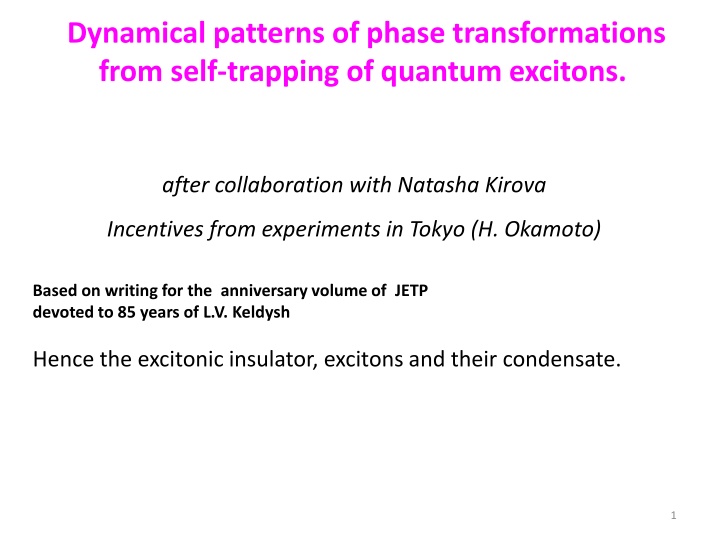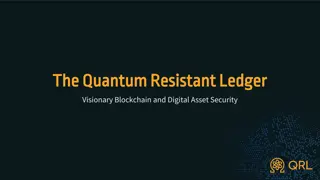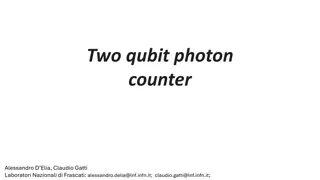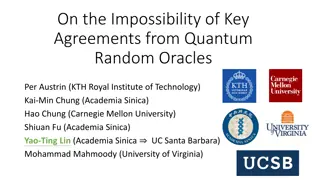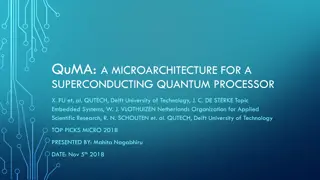from self-trapping of quantum excitons.
Dive into the dynamical patterns of phase transformations resulting from self-trapping of quantum excitons, following collaboration and experiments in Tokyo. Delve into the world of excitonic insulators, excitons, and their condensates as discussed in the anniversary volume of JETP dedicated to L.V. Keldysh. Discover the intricate interactions of excitons with the order parameter, leading to phenomena such as entangled Bose condensation and excitonic insulator transitions. Unravel the complex dynamics of excitons at subcritical pumping and their evolution in media prone to instabilities.
Download Presentation

Please find below an Image/Link to download the presentation.
The content on the website is provided AS IS for your information and personal use only. It may not be sold, licensed, or shared on other websites without obtaining consent from the author.If you encounter any issues during the download, it is possible that the publisher has removed the file from their server.
You are allowed to download the files provided on this website for personal or commercial use, subject to the condition that they are used lawfully. All files are the property of their respective owners.
The content on the website is provided AS IS for your information and personal use only. It may not be sold, licensed, or shared on other websites without obtaining consent from the author.
E N D
Presentation Transcript
Dynamical patterns of phase transformations from self-trapping of quantum excitons. after collaboration with Natasha Kirova Incentives from experiments in Tokyo (H. Okamoto) Based on writing for the anniversary volume of JETP devoted to 85 years of L.V. Keldysh Hence the excitonic insulator, excitons and their condensate. 1
PUMPING TO EXCITONS - OUTLINE Introduction. Time resolved phase transformations induced by optical pumping of excitons in a media prone to an instability. The workshop of excitons in donor-acceptor chains with neutral-ionic transitions. Intramolecular excitons interacting with the order parameter: Spacio-temporal evolution: space segregation from self-focusing. Local dynamic transitions at subcritical pumping. Charge transfer excitons merging with the order parameter: Entangled Bose condensation of excitons and the Excitonic Insulator transition for the thermodynamic order parameter. Coherent oscillations from quantum interference in the excitonic condensate and the excitonic insulator ground state. Conclusions, confusions, unsolved problems.
10s fs 100 fs non-equilibrium populations of electrons e and holes h. empty bands electrons Spectral gap or bottleneck Alternative: subgap pumping to excitons e-h bound states optical pumping holes filled bands At high density and cooled, excitons might form a quasi-condensate. Wave function of this macroscopic quantum state evolves interacting with other degrees of freedom prone to instability. is subject to self-trapping (akin to self-focusing of light). Locally enhanced density can trigger the phase transformation, even if the mean density is below the global threshold.
Neutral-Ionic Transition in donor-acceptor chains. TTF-CA: stacks of alternating donors D=TTF and acceptors A=CA. T>Tc=81 K: molecules are weakly charged. T=Tc: quasi-neutral to ionic transition 1st order. Charge transfer jumps from n =0.32 to i = 0.52 Charged molecules shift relative to each other Coulomb or spin-Peierls instabilities: alternation of long and short bonds. With all inversion and mirror symmetries lifted, this is the electronic ferroelectric. Tokura teams, Nagaosa, Koshihara and Okamoto, Luty , Caileux Thermodynamic charge transfer. redistribution of the charge density with no symmetry breaking - an isomorphic transition described by the single real field r = - n. Actually symmetry breaking because of the complementary dimerization; Still of the 1st order by influence of Primary effect: 4
Common picture: phase transitions via formation of strings and walls. Well accepted in equilibrium, its shown here wide use in dynamics assumes the light absorption by a single molecule or a dimer. Contradiction to the optical exciton as a delocalized quantum wave with the momentum p=0. Our view: selftraping rather than domino.
Donor-acceptor chains - workshop for pumping of excitons Intra-molecular excitons IME (S. Koshihara) Pumping into the IME : the excitons and the order parameter are different while interacting fields. CTE, 0.6 eV Inter-molecular = charge-transfer excitons CTE (H. Okamoto). Both the exciton and the charge ordering are built from processes of electronic transfer with a density = n+r between donor and acceptor molecules. IME, 2.4 eV
EXCITONS and PHOTO INDUCED PHASE TRANSITIONS Resonance pumping to excitons or Intermediate stage after the electronic pumping. Excitons: initially delocalized (photon k=0) High density, a quasi-condensate, a macroscopic quantum state. Wave function whichevolves interacting with other degrees of freedom prone to instability. Subject to self-trapping (akin to self-focusing of light). Locally enhanced density can trigger the phase transformation, even if the mean density is below the global threshold. N.B. Exciton is a quantum state in both the internal and the center of mass coordinats
Charge Transfer Excitons pumped in a media prone to the Charge Transfer instability. Both the exciton and the charge ordering are built from processes of electronic transfer between donor and acceptor molecules. Thermodynamic order parameter and intensity of pumped excitation are of the same origin. Density of excitons q=| |2 is not distinguishable from the thermodynamic order parameter r= - n. To treat both thermodynamic and dynamic effects on the same root, we adopt for the phase transition a view of the Excitonic Insulator (EI). 1960 s: Knox, Cloizeau, Kohn et al, Halperin and Rice, Keldysh et al, Kozlov and Maksimov - well revived nowadays experimentally and in theory. EI is a nickname of a hypothetical phase of a semiconductor which appears if the total energy of an exciton Eex=Eg-Eb vanishes: Eex 0. Eg Eb Eex 0 8
Excitonic insulator instability when the exciton energy goes to zero. The most general concept Eex=0 covers all non-metallic quantum phase transitions. The focused concept of the EI is distinguished when the number of excitons, both in the ground state and out-of-equilibrium, is approximately conserved. (If it were conserved precisely, then there would be no dynamical path to the EI state which is of particular importance in the context of PIPT.) Microscopic theories of the Bose condensate of pumped excitons and of the EI transition are closely related, differing mostly by monitoring parameters: the chemical potential exand the density nex. That allows to build a model describing jointly the dynamics of excitons and the evolution of the phase transition after the pumping. 9
The minimal model for the CTE interacting with the symmetry breaking order. The energy W(q,h) : a b c f ( ) = + + + + 2 3 2 4 / 1 W E q q q q q h h ex c 2 3 2 4 q q charge transfer = excitons density h lattice deformation qc critical value of q to initiate h h excitons attraction excitons creation V(q) Energy W(q,h) potential V(q,h) minimization over h. V=dW/dq W*(q) and the V*(q) after W(q) 4 intervals of q: repulsion, attraction, creation, repulsion of excitons
Enigma: thermodynamic charge transfer = redistribution of the charge density q is a single real non-conserved field. 2 2 / / d q dt dW dq Charge transfer under pumping 1. is the conserved field q=| |2 2. = | | exp(i ) : the phase - appears as a hidden degree of freedom. 11
Resolution with a hint from (Keldysh and Kozlov, 1972) Take into account additionally: Matrix element of Coulomb interactions transferring two electrons across the gap, from filled to empty band = simultaneous creation or annihilation of two e-h pairs creation/destruction of excitons pairs from/to the vacuum. These virtual transitions become real for macroscopic concentration. normal -> Eex| |2 anomalous -> S( 2 + *2 ) e h e e h h h e S-term fixes the wave function phase in the EI ground state. Dynamically it gives rise to oscillations of quantum interference among states which numbers of excitons differ by 2.
Generalized Gross-Pitaevskii eq. for evolution of excitons wave function = + = i 2 p / 2 ( , ) H M V q h i H S t (q,h) =decay/creation rate for the excitons density q: 1. constant at q 0 (single-particle recombination) neglect in modeling, 2. q at moderate q (BE statistics - stimulated emission), 3. vanishes in the minimum of W at q q0 - no way to release the energy, hence the guess as V(q) if S=0. The interpolation (q,h) qV(q,h) ensures the relaxation towards the local energy minimas at q 0 and at q q0. At S 0, with the phase dependence: the generalization: ( , ) ( , ) q h qV q h V(q) W(q) ( ) qE t q ex t
No space dependence: a homogeneous regime or multi-stable quantum dot - switching by absorbing the exciton, polar variables: q = + sin( 2 ) ( , ) q Sq q h Kq t t t = + cos( 2 ) V S describes the relaxation of the amplitude. S-term gives rise to either locking of the phase approaching the EI phase, when |V|<S , or to oscillations of quantum interference among states which numbers of excitons differ by 2. 2 h 2 2 1 h s h + + + = 3 1 ( h / ) 0 fh q c q 2 2 2 2 t t x
Pumping to the EI state. Generic model- no lattice component h. Case of the first order phase transition. High pumping. Oscillations from the macroscopic quantum interference and dynamic lock-in transition back to the EI. Locked EI BEC evolution Time dependence of q(t), (t) and the polar trajectory q( ) for the generic EI after an additional pumping. gets an increment 2 16
Generic model - no lattice contribution. Case of the first order phase transition, critical pumping. Oscillations from the macroscopic quantum interference and dynamic lock-in transition from the virgin to the EI state. q Time dependencies and the polar trajectory towards the metastable EI after a just super-barrier pumping of the virgin state. 17
Space-time modeling, super-critical and higher pumping, S 0:
Conclusions Intra-molecular and charge transfer excitons A quasi-condensate of optically pumped excitons appears as a macroscopic quantum state. It evolves interacting with other degrees of freedom prone to instability, with self-trapping of excitons akin to self-focusing in optics. The locally enhanced density of excitons can surpass a critical value to trigger the phase transformation, even if the mean density is below the required threshold. The system is stratified in domains which evolve through dynamical phase transitions and may persist even after the excitons recombine. Charge transfer excitons The excitation and the long range ordering can be built from the same intermolecular electronic transfer. Both thermodynamic and dynamic effects can be described on the same root by viewing the ordered state as the Excitonic Insulator. 24
